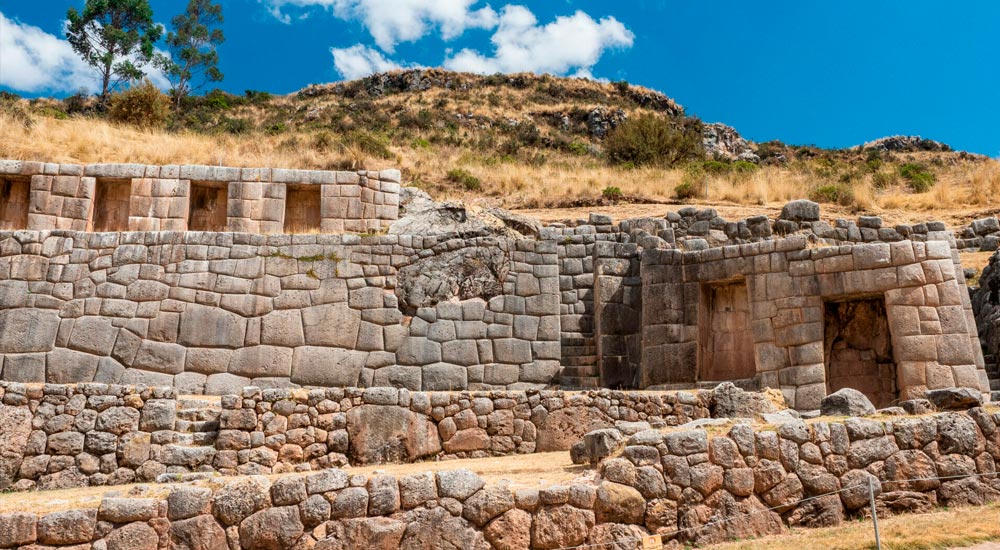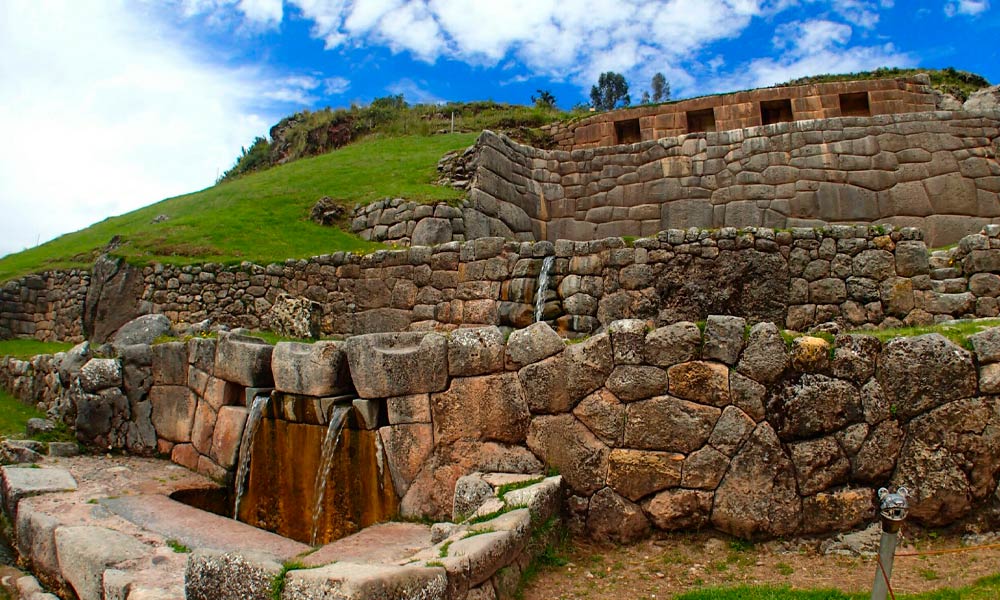Nestled in the Andean highlands of Peru, near the city of Cusco, lies water temple Tambomachay, an ancient archaeological site that has captivated the imagination of history enthusiasts and spiritual travelers alike. This hidden gem, often overshadowed by the fame of its neighboring sites like Machu Picchu and Sacsayhuamán, holds an air of mystery and reverence that’s worth exploring. In this comprehensive guide, we’ll unveil the secrets of water temple Tambomachay, its history, its cultural significance, and the spiritual aura that surrounds it. Get ready to embark on a journey through time and spirituality as we uncover the enigmatic allure of Tambomachay.
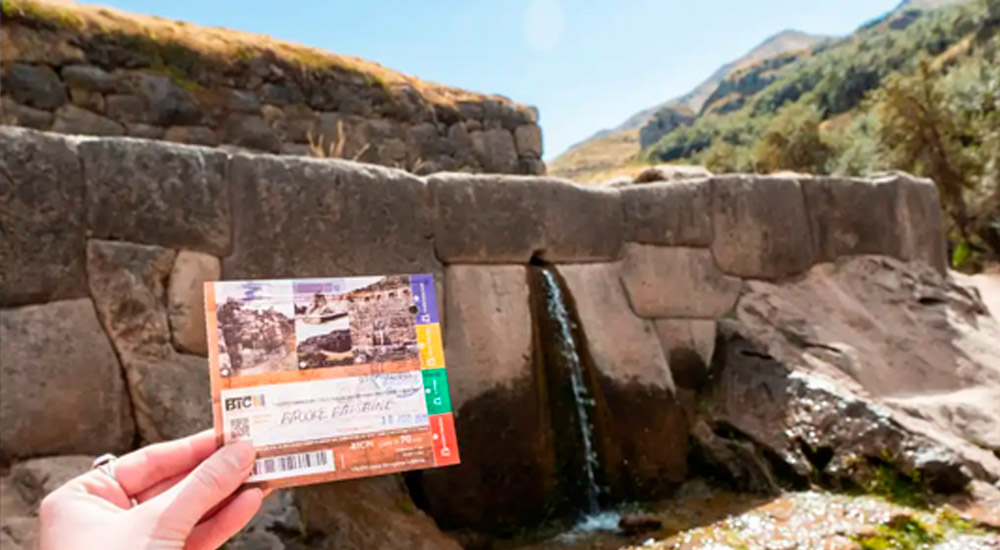
Origins and Significance
Unveiling the Name: Tambomachay’s name offers a fascinating glimpse into the history of this enigmatic site. The term “Tambomachay” is a fusion of two Quechua words: “tampu,” meaning “guest house,” and “machay,” which translates to “resting place.” This nomenclature invites us to speculate about the functions Tambomachay may have served during the Inca era.
The “guest house” component of the name hints at the possibility that Tambomachay might have played a role as a kind of inn or resting point for travelers along the Inca road network. Considering its location near Cusco and its access to freshwater, it could have been a place where weary travelers found respite, sustenance, and a chance to recharge before continuing their journeys.
In addition to its function as a “tampu,” Tambomachay’s name also underscores its significance as a “machay,” a resting place. This highlights its potential use as a location of spiritual or ritual importance. It suggests that it might have been a site where the Incas and their priests took a pause for religious ceremonies or as a part of a broader pilgrimage through the Andean landscape.
Inca Engineering Marvel: Tambomachay’s architectural design and water management system are nothing short of remarkable. The Inca civilization was known for its precision in stone carving and astute understanding of natural elements, and Tambomachay is a prime example of this expertise. The site’s meticulous stone construction, with finely cut stones fitted together without the use of mortar, showcases the Inca’s skill in stonemasonry. The aqueducts, terraces, and canals that interlace the site emphasize the Inca’s ability to harness the flow of water in their engineering, catering to both practical and ceremonial needs.
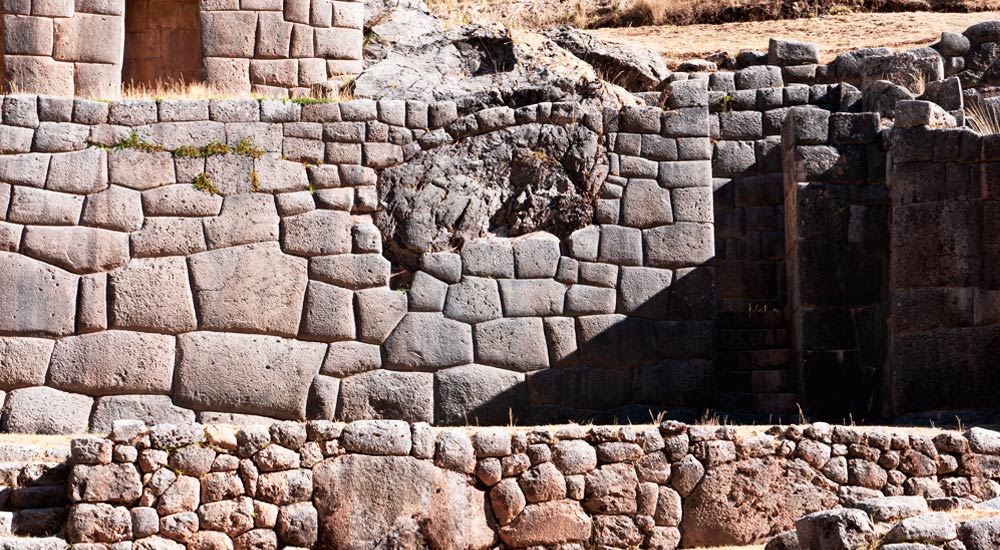
The architectural brilliance of water temple Tambomachay extends to its terraced construction, which enabled microclimates for diverse crops, a testament to the Inca’s agricultural prowess. Through ingenious design and a profound understanding of the Andean environment, they created a sustainable system for their society.
Exploring Tambomachay’s architectural and engineering marvels takes us on a journey back in time to an era where the Incas harmoniously blended practicality with spiritual significance, revealing a civilization that celebrated the natural world in its construction and daily life.
Functions and Theories
The Water Temple Hypothesis: One of the prominent and intriguing theories about Tambomachay proposes that it was a sacred site dedicated to water worship and purification. This theory is rooted in the site’s remarkable water-related features and their potential spiritual significance.
Tambomachay’s numerous canals, aqueducts, and cascades are considered the primary pieces of evidence supporting the water temple hypothesis. The Incas’ exceptional mastery of water management is evident in the intricate system of channels that bring fresh, flowing water to the site. The clarity and purity of this water source is a significant aspect of the theory. The Incas revered water for its life-giving properties, and the fact that Tambomachay boasts pristine, clear water could indicate its importance in rituals and ceremonies involving water purification.
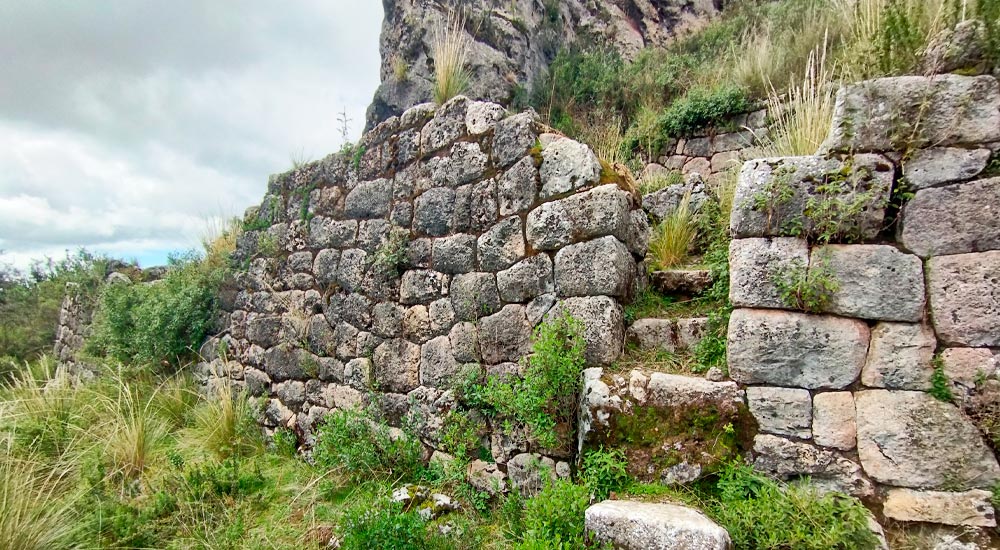
The concept of water worship was a vital part of Inca spirituality. The Incas held the belief that natural elements, including water, were inhabited by spirits or deities, and they conducted ceremonies to honor and seek blessings from these elemental forces. Tambomachay’s series of ceremonial fountains and baths add further weight to the theory of water-related rituals. The cascades, designed with carved stone spouts, could have been used for ritualistic purification, where water was employed for spiritual cleansing and renewal. This aligns with Inca practices of using natural elements as a means of connecting with the divine.
Understanding Tambomachay through the lens of a water temple illuminates the profound spiritual connection the Inca civilization had with the environment and the elements. It transforms the site into a sanctuary where rituals involving water were carried out, deepening our appreciation of the Inca’s reverence for the natural world.
A Royal Retreat: In addition to its spiritual significance, another theory suggests that Tambomachay might have been a royal estate or retreat for the Inca elite. This theory reshapes our understanding of the site, portraying it as a place of leisure, relaxation, and potentially even strategic importance.
Evidence supporting this notion includes the quality of construction and the site’s proximity to Cusco. The exceptional craftsmanship displayed in the architecture, the well-structured terraces, and the meticulous stonework are all indicative of the Inca’s tendency to reserve such excellence for places of prestige. Furthermore, the proximity of Tambomachay to Cusco, the Inca capital, is another compelling point. It’s not uncommon for rulers to establish their retreats or estates near the seat of power for ease of access.
This theory transforms Tambomachay into a place where Inca rulers could have sought refuge from the hustle and bustle of the capital, possibly to escape political matters, engage in recreational activities, or connect with nature. Viewing Tambomachay as a royal estate broadens the site’s narrative, making it not only a place of spiritual and cultural significance but also a window into the leisurely lives and preferences of the Inca elite.
Rituals and Spirituality
Spiritual Significance: Tambomachay’s pristine water features are closely linked to spiritual purification, a central element in the Andean cosmology of the Incas. Water was considered a sacred and life-giving element, often associated with the divine. In the Inca belief system, natural elements like water, mountains, and the sun were believed to house powerful spirits or deities. Tambomachay’s abundant, clear water and the unique way it is channeled through aqueducts and fountains suggest its role in spiritual rituals and ceremonies.
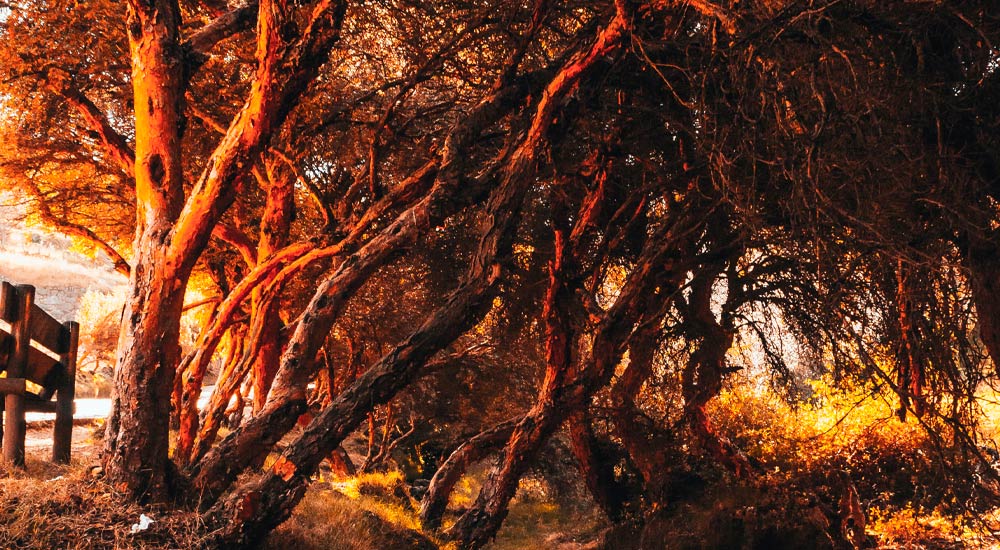
Water purification held deep spiritual meaning for the Incas. Ritual baths and ceremonial cleansings were common practices that allowed individuals to purify themselves, renew their spiritual connection, and seek blessings from the deities inhabiting the elements. Tambomachay’s cascades, with finely carved stone spouts, could have been used for such spiritual purifications. The site’s location near Cusco, the capital of the Inca Empire, implies its significance in both political and spiritual contexts.
The cascades and bathing areas at Tambomachay may have been used for ceremonial ablutions. In these rituals, water was utilized to cleanse participants before important religious ceremonies or events. The act of purifying with the clear, flowing water symbolized a spiritual renewal, preparing individuals to engage with the divine more holistically. Visitors to Tambomachay could explore this spiritual significance by immersing themselves in the sacred atmosphere and imagining the rituals that might have transpired here.
Inti Raymi Connection: Investigating a potential link between Tambomachay and the grand Inti Raymi festival opens an exciting avenue for understanding the site’s role in Inca culture. The Inti Raymi festival, also known as the Festival of the Sun, was one of the most significant Inca celebrations, dedicated to honoring the Sun God, Inti.
While there’s no concrete historical evidence directly associating Tambomachay with Inti Raymi, some theories suggest its possible involvement. The proximity of Tambomachay to Cusco makes it a plausible location for preparatory or cleansing rituals before the grand festival. It’s conceivable that participants in the Inti Raymi ceremonies might have visited Tambomachay for ritual purifications before proceeding to the Coricancha, the primary venue for the festival. The site’s connection to water and its potential role in spiritual purification align with the themes of the Inti Raymi festival.
Immersing yourself in the discussion of Tambomachay’s spiritual significance and its relation to the Inti Raymi festival offers a more profound insight into the religious and ceremonial practices of the Inca civilization, connecting visitors to the spiritual heartbeat of this ancient culture.
Tambomachay Today
Visitor Experience: Exploring Tambomachay in modern times offers a unique opportunity to journey back in history and connect with the ancient Inca civilization. To reach Tambomachay, visitors can generally hire a taxi or join guided tours from Cusco, which is merely a few kilometers away. The journey is not only one of distance but of time, as you traverse through the picturesque Peruvian landscape, alluding to the epic history that you’re about to encounter.

Upon arrival at Tambomachay, visitors often find themselves surrounded by lush, scenic beauty. The site’s location is nestled in the rolling hills, with the stunning backdrop of the Andes Mountains. You can expect to witness an awe-inspiring display of Inca engineering, with well-preserved aqueducts, cascading fountains, and beautifully crafted stonework.
For those interested in the historical and cultural context of Tambomachay, guided tours are widely available. These knowledgeable guides provide insights into the site’s history, architectural significance, and potential functions. Their expertise brings the ruins to life, allowing you to truly appreciate the genius of the Inca civilization.
Preservation and Conservation: Tambomachay’s preservation and conservation are of paramount importance to ensure its historical and cultural significance remains intact for future generations. Efforts to safeguard this archaeological treasure include maintaining the structural integrity of the site and protecting it from erosion and environmental factors.
Local and national authorities work hand in hand to preserve Tambomachay. Conservation efforts involve ongoing maintenance, site monitoring, and strategies to mitigate the impact of visitors. Ensuring the site’s protection and longevity is not just about safeguarding physical structures; it’s also about preserving the stories, heritage, and spiritual essence that Tambomachay represents.
By exploring Tambomachay and learning about these preservation initiatives, visitors can become actively involved in the site’s continued protection. Respecting the rules and guidelines while visiting, such as not touching or removing any stones or relics, and adhering to sustainable tourism practices, is a way for visitors to contribute to Tambomachay’s preservation and conservation. This sacred place serves as a link between the past and the present, allowing travelers to connect with history, culture, and nature in one unforgettable experience.
The Mystique of Tambomachay
Unraveling the Mysteries: Tambomachay is veiled in an air of mystery, which only deepens its allure. It’s not uncommon to hear tales of secret tunnels and hidden chambers concealed beneath the site. While there’s limited empirical evidence to confirm these stories, they add an extra layer of fascination to Tambomachay’s legacy. This leads to speculation about the complex network of tunnels and chambers that may have connected Tambomachay with other important sites in the vicinity. These legends invite modern explorers to imagine what might remain concealed beneath the earth, waiting to be unveiled.
Spiritual Encounters: What makes Tambomachay even more captivating is the profound spiritual aura that envelopes the site. Many visitors report experiencing a deep sense of tranquility, reverence, and even connection to the spiritual world when exploring these ancient ruins. It’s as if the whispers of the Inca past linger in the air, inviting contemplation and introspection.
This mystical energy is often attributed to the site’s relationship with water. In Andean cosmology, water is a sacred element, representing life and purification. This belief, coupled with the tangible presence of cascading fountains and aqueducts, creates a space for spiritual reflection. Some travelers choose to meditate by the serene pools or sit quietly near the ancient stone constructions, seeking a connection with the spiritual energies that are believed to reside in these historic stones.
Whether driven by the inherent mystique of Tambomachay or the ancient belief in the spiritual significance of water, visitors are likely to find a deep sense of calm and a unique opportunity for personal reflection when wandering through this incredible site. It’s a destination that invites visitors not only to learn about history but to experience it in a profound and often deeply personal way.
Tambomachay, often dubbed the “Baños del Inca” (Baths of the Inca), continues to be a source of fascination, not only for its historical significance but also for its spiritual aura. It stands as a testament to the advanced engineering skills of the Inca and their deep reverence for water. Whether you’re a history enthusiast, a spiritual seeker, or an adventurous traveler, Tambomachay offers a unique experience that connects you with the ancient Inca world. So, venture beyond the well-trodden paths and discover the enigmatic water temple of Tambomachay – a place where history and mystique intertwine.

